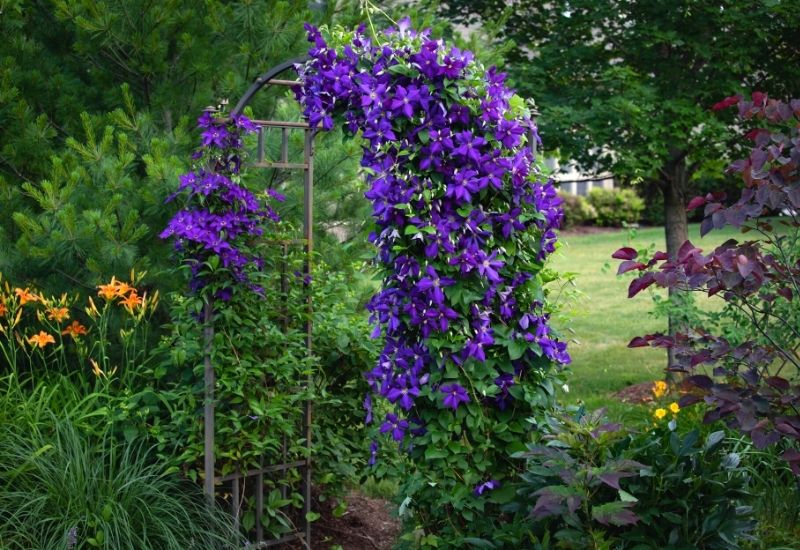
What’s best on a summer’s afternoon than sitting in the shade surrounded by flowering vines? The leaves that frame your view… the flowers that blossom at eye level… and all this while you shelter from the heat of the Sun in that fresh corner of your garden…
If you too enjoy this dream, and you want to realize it you will need some shade-tolerant flowering vines.
In Nature, some vines grow on tree trunks, especially in tropical forests. This has given rise to a fair number of garden varieties and cultivars that you can grow in that poorly lit part of your garden. And they are great companions to relax with away from the heat of the summer Sun.
Whether your have a gazebo, trellis, pergola, arbor or fence that needs some colorful vine and life and it’s in the shade your troubles are over. Why?
There are lots of possibilities for flowering climbers that will thrive nicely in the low-light areas of your garden.
Here are the 20 most beautiful shade-loving flowering vines, along with a guide to when they bloom and gardening ideas for how and where you should consider planting these blooming beauties.
I bet you are surprised to find roses and wisteria in this list! Yet it’s correct, but let’s talk about light and shade in gardening terms first, because most people are mistaken about what we mean…
Vines, Sun and Shade
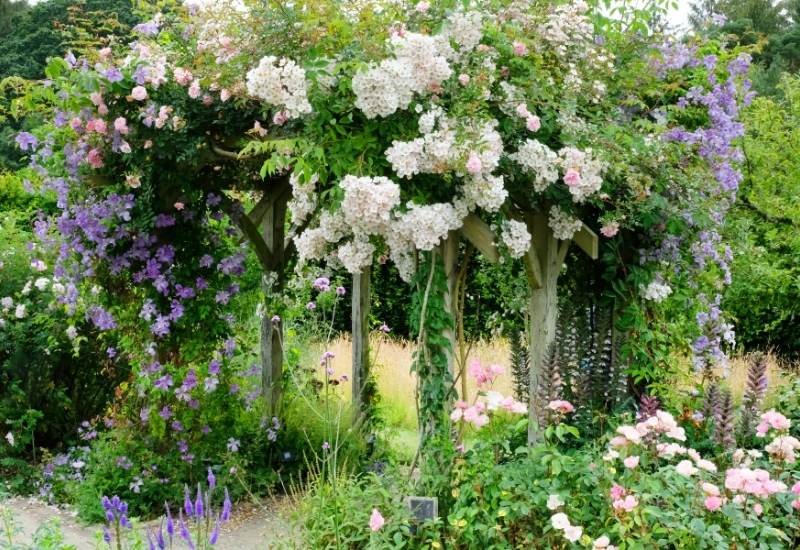
Vines are plants that can’t support themselves. So they “hang on” to other plants or strong structures.
They can do it by using tendrils, which are “twisting branchlets” or by winding around the support with their stems.
Wisteria is arguably the most popular winding flowering vine in the world. Grapes on the other hand, use tendrils…
Unfortunately, you won’t be able to grow either grapes part shade or full shade: they love lots of light!
But there are quite a few vines that can grow in partial shade or even full shade, and Chinese wisteria is one of them!
Do you want some more? Bleeding heart and even sweet peas can grow in fairly shady places…
You can see your shady spot filling with flowers now, but let me add a little note…
Is Your Garden in Full Shade or Partial Shade?
Maybe you don’t have the whole of your garden in mind when you think about sunlight and shade. In fact most likely you are thinking about a particular spot.
But what do we mean by full shade and partial shade? Let me tell you that the chances are that the spot you have in mind is in partial shade not full shade! I’ll explain…
Full shade does not even literally mean “full shade”, as full Sun does not mean “always in the Sun”! full shade means that the spot receives less than 3 hours of bright light every day. This does not mean “direct sunlight”, but light that is bright even if indirect.
Similarly, partial shade means that the spot receives between 3 and 6 hours of bright light on average every day. Most “shady spots” are in partial shade. Even that fresh corner of your garden will have enough indirect light every day to class as partial shade most likely.
And how about full Sun? it means anything above 6 hours of bright light every day. So, things may not look as desperate now that you know what these terms actually mean… and now that you know where to fit your beloved spot in your garden, let’s see if we can start to make it blossom with our flowering vines!
Top 20 Prettiest Flowering Vines for Shade
Always with colorful blooms and often with fragrant flowers as well, these 20 vining flowering vines will turn that sad and shady spot that’s troubling you into a corner of paradise you’ll be proud of.
1. Chinese Wisteria (Wisteria sinensis)
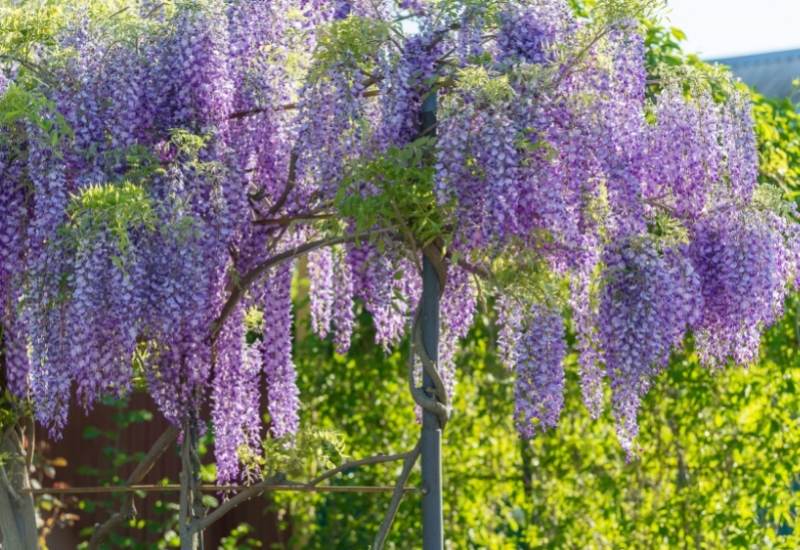
Wisteria is the queen of flowering vines, and the Chinese variety can grow in partial shade (as well as full Sun).
We all know how beautiful the fragrant blooms of this spectacular winding vine are; they are the subject of many pictures, videos and of legend, literally!
But while it likes bright light, it Chinese wisteria can grow well in partial shade, in fact, it often grows under the canopies of trees in Nature.
One fun fact about wisteria? Chinese wisteria always climbs winding clockwise, while Japanese wisteria climbs anti-clockwise. Be aware of this when you place the support for your chosen variety.
2. Chocolate Vine (Akebia quinata)
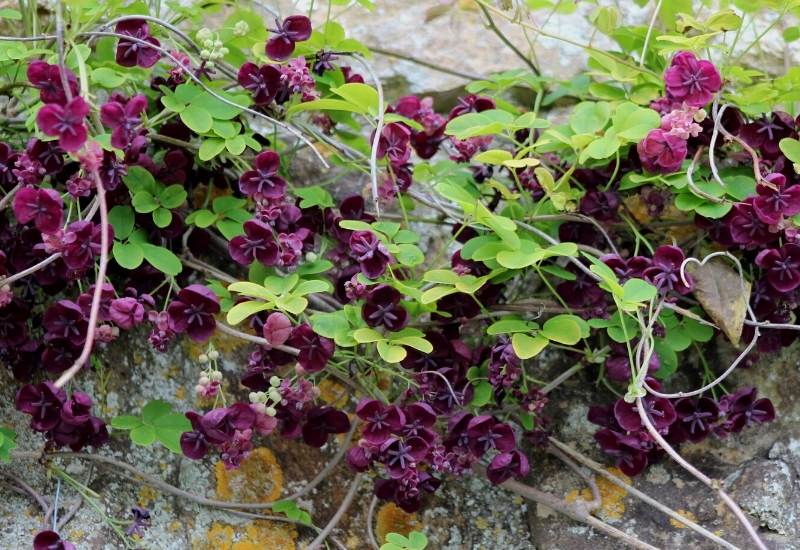
Chocolate vine is a wonder of Nature and you can even grow it even in full shade! So, if your spot is really on the dark side – well, how about a semi evergreen climber with light green leaves that look like clover and amazing dark purple hanging flowers with three petals each?
The flowers come in small very fragrant clusters and they open from pink buds. For this reason, you chocolate vine is perfect for elegant gardens and traditional designs.
Guess what? This beauty has won the Award of Garden Merit by the Royal Horticultural Society.
3. Clematis (Clematis spp.)
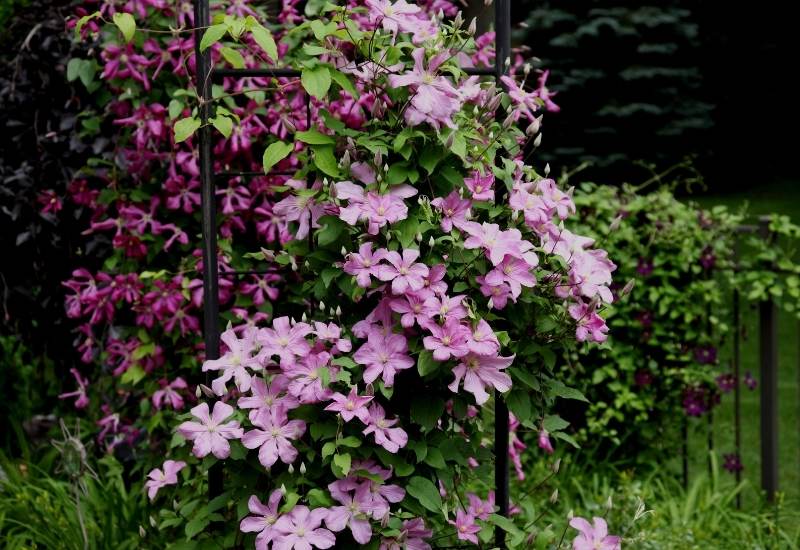
Clematis is yet another classic perennial vine that likes to grow in partial shade.
Even more, it likes to have its “feet cold”; the base of the plant and the roots need to be fresh and away from direct Sun.
Once you sort this out you can enjoy its large, showy and exotic looking flowers in all the palette of white to violet via pink and magenta this perennial has.
And some varieties have flowers that can reach 8 inches across (20 cm)!
Clematis is excellent on walls and fences. Not theta there are early blooming varieties and late blooming varieties, so you can time the blossom of your clematis when it best suits you.
4. Dipladenia (Madenvilla boliviensis)
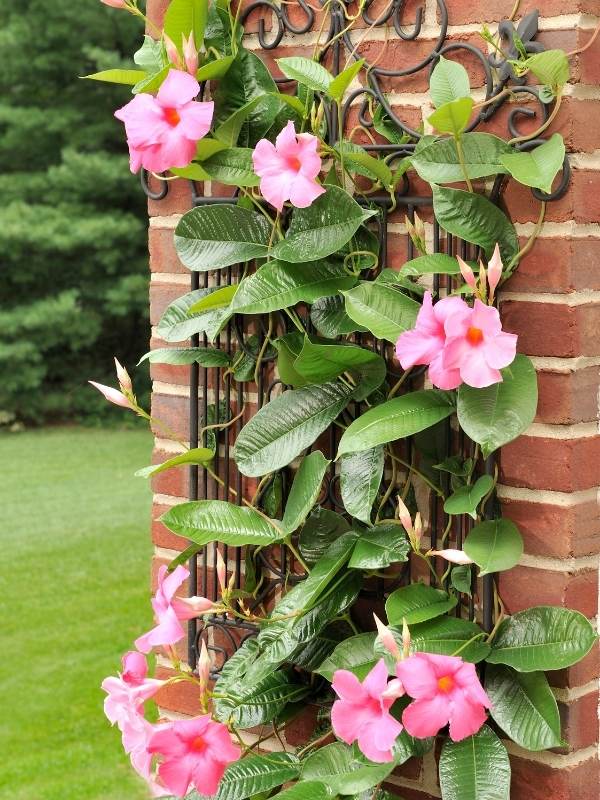
Dipladenia is becoming all the rage where I live, and it too will like some shade. The funnel shaped flowers if this twining vine can be 3 inches across (7.5 cm).
These are usually bright red or snow white with a yellow center and and the 5 pointed petals are elegant and showy at the same time.
The foliage too is very beautiful, glossy and tropical looking. It too is a winner of the Award of Garden Merit by the Royal Horticultural Society.
Dipladenia is great for most garden designs. This evergreen tropical vine looks great in traditional and informal gardens but it will not look amiss in a formal setting. Finally, it is an excellent shade vine for containers and even hanging baskets.
5. Trumpet Vine (Campsis radicans)
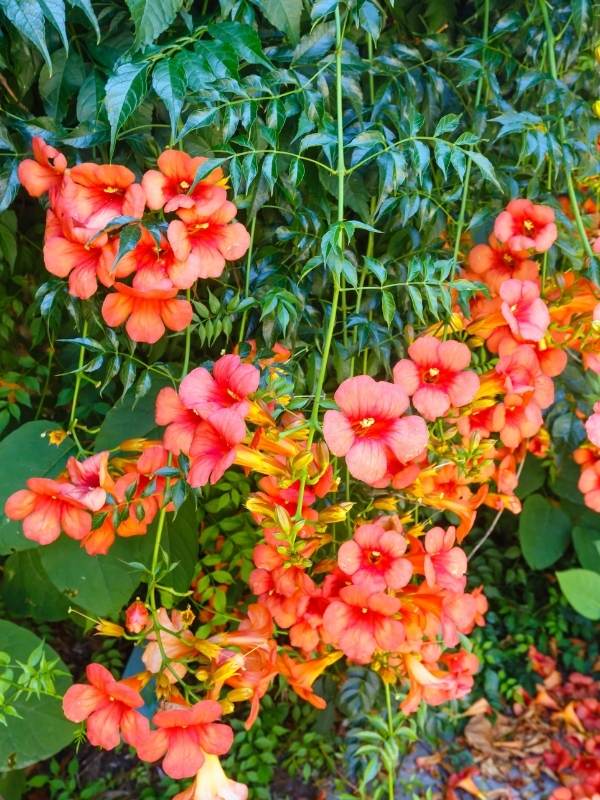
Light up that corner in the shade at the back of your garden with the bright orange trumpet shaped flowers of this beautiful and fast-growing perennial vine.
The flowers form large clusters of bright and lively orange at the end of very thin stems. At the same time, the pinnate dark green and quite attractive foliage sets them off very nicely. There are also yellow and red cultivars if you wish!
Trumpet vine is ideal for fences and walls, but also on pergolas it can work wonders. It’s an elegant plant but its ideal setting is informal. However, it will suit a temperate or tropical design alike.
6. Spurred Butterfly Pea (Centrosema virginianum)
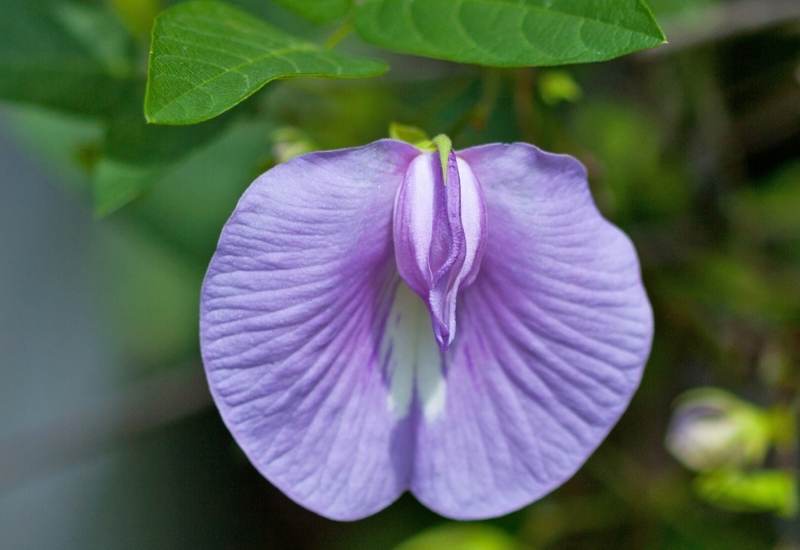
Spurred butterfly pea has large lavender flowers that hang upside down on rich elliptical vining foliage and it will like a bit of shade as well.
It is of the pea family, so the flowers have that original shape with keel and banner petals. But the foliage looks less tender, more established and darker.
It is a less known climber, which you can also use as ground cover. It is fast growing and very low maintenance. So, give it a go; it will look lovely in an informal garden!
7. Cross Vine (Bignonia capreolata)
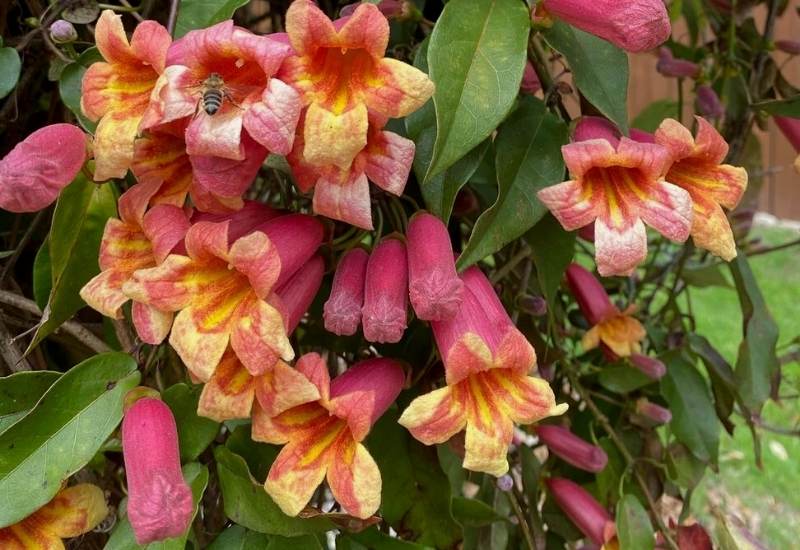
Let me introduce you to another lesser known climbing perennial with beautiful flowers that appreciates some shade: cross vine. It is a woody wine that grows fast and clings to supports naturally.
It produces lovely dark green compound foliage. But by spring it will fill with fragrant and showy trumpet shaped flowers. You won’t miss them, because they are bright yellow, red and orange!
Cross vine is excellent to cover walls and unsightly structures, because its foliage is thick and it grows fast. And as you know, these ugly walls and structures tend to hide in shady corners…
8. American Groundnut (Apios americana)
Here we go with another unusual blooming climber you can grow in partials shade: American groundnut! This top has pea like flowers, but they are fleshy and fragrant too.
They come in dense racemes and the are pale pink brown outside and dark reddish brown inside. Then, edible brown pods will follow in the fall. And all is set against a finely textured foliage of pinnate leaves.
This is an excellent climber with unusual flowers and a double purpose. You can admire it, but also eat both the pods and the tubers.
It is in fact a super nutritious plant, rich in calcium and iron and with three times the protein content of potatoes!
9. Virgin’s Bower (Clematis virginiana)
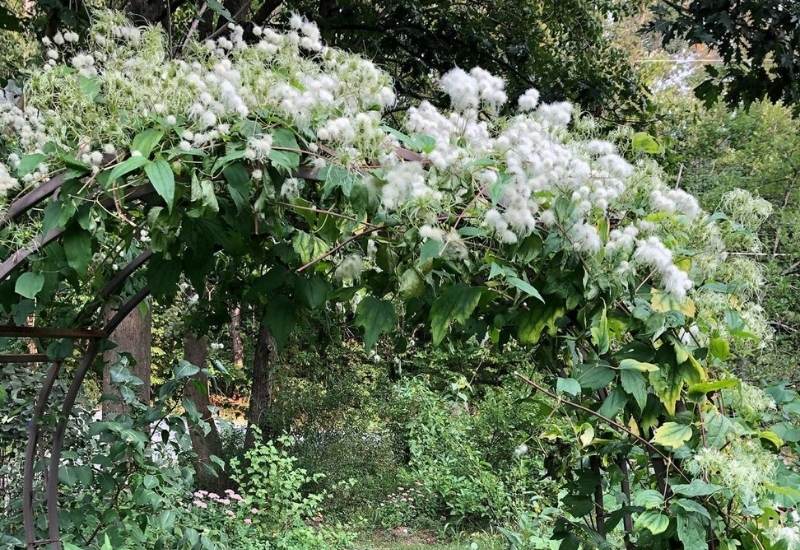
Virgin’s bower is a cold hardy and shade-loving climber that outs on a “nuptial” show even where light isn’t strong. It looks a bit like a bride walking to the altar, as it fills with a sea of fragrant white flowers like starlets or pearls over the light green foliage.
These are the male flowers. But in winter, you get the female flowers too. And they follow the same theme: they are fluffy and white…
Virgin bower is a romantic plant and it is excellent for a light and bright but delicate look and to keep your garden interesting all year round.
10. Dutchman’s Pipe (Aristolochia macrophylla)
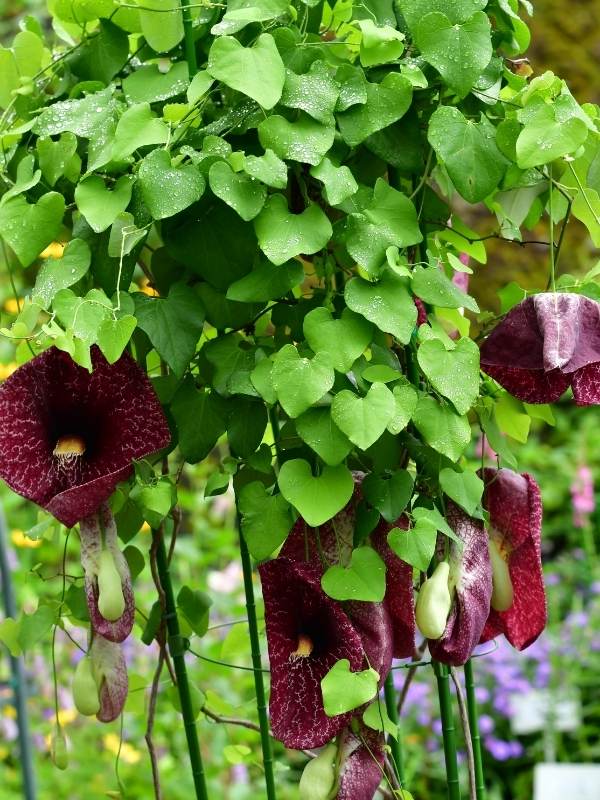
Dutchman’s pipe is the best climber to grow for an original and exotic looking area in partial shade. The leaves are heart shaped, green, tender looking and huge! This vigorous vine can be a foot long (30 cm).
And how can I describe the flowers? They look like weird curbed trumpets out of a painting by Salvador Dalì! If you want a plant that looks like it hails from another world…
Dutchman’s pipe is great on pergolas and trellises. It won’t fully cover walls, as the foliage is large but sparse. In any case, this plant gives lots of structure and depth to gardens.
11. Swamp Leatherflower (Clematis crispa)
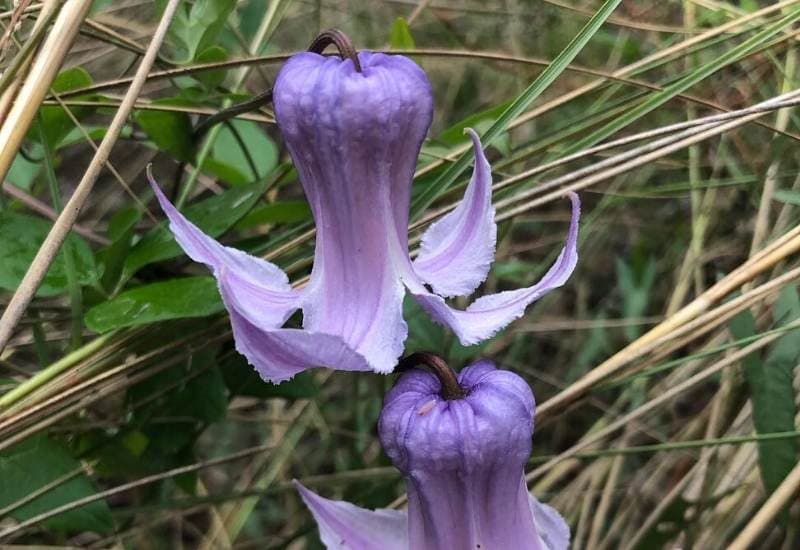
Swamp leatherflower a.k.a. blue jasmine is actually an unusual clematis of the “virona group” with nodding bell shaped flowers that enjoys some shade.
The flower heads can be 2 inches wide (5 cm) which is not a lot for clematis, but this vine will produce loads and they are fragrant and violet blue in color.
Then the seedheads look like fluffy brushes on top of the very lush showy foliage. Did I mention that it will bloom from spring to the first frost?
It’s a plant you want to make your garden stand out, even if you can’t afford full Sun! And pollinators really love it!
12. Common Hop (Humulus Lupulus)
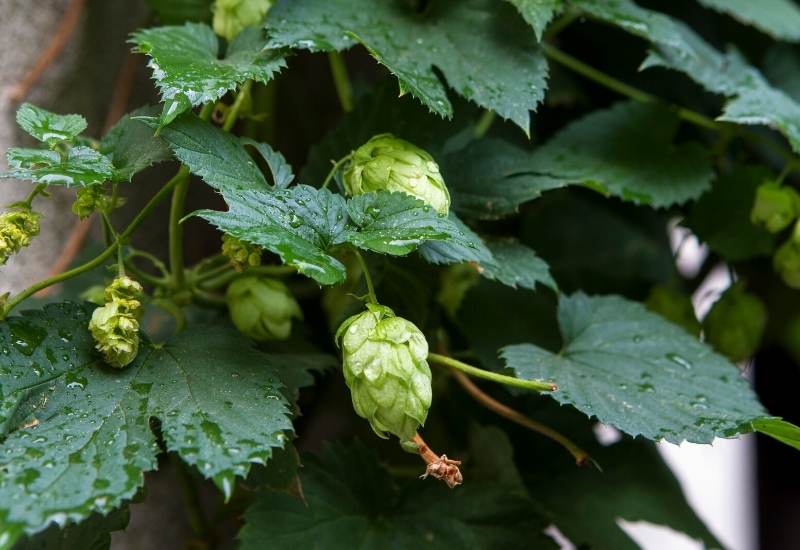
Have you thought about growing fragrant hop in your garden? It won’t mind a bit of shade! This beautiful and useful climber grows fast, covering fences and pergolas with rich foliage with a year.
The flowers are famous, they are lime green, aromatic and they look like little feathery cones that nod under the leaves!
Maybe common hop is not ideal for a gazebo, but for that area of your garden in partial shade that you want covered quickly, why not grow this famous aromatic plant?
13. Prairie Rose (Rosa setigera)
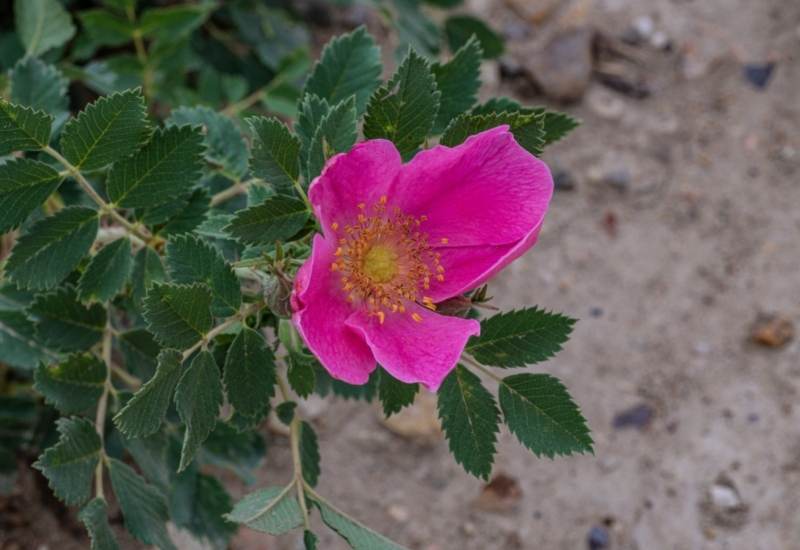
Yes, you can even grow climbing roses in partial shade! Some roses are in fact perfectly fine with it, especially vining ones. And prairie rose, with its beautiful natural look is one of my favorites.
It is a single and flat flowered rose with a visible gold pistils surrounded by magenta to very pale lavender petals. They are fragrant and they are followed by red rose hips.
Prairie rose is excellent for any type of informal garden, but I think its very vest setting would be an English country garden or cottage garden design.
14. Carolina Jasmine (Gelsemium sempervivirens)
Even in partial shade, Carolina jasmine is very generous with its massive and fragrant blooms! This twining vine fills with a sea of butter yellow trumpet shaped flowers from late winter and it keeps giving till the end of spring!
It is not actually a jasmine, but because of the huge blossoms and the scent, it has gained the honorary name. As it has also won the Award of Garden Merit by the Royal Horticultural Society.
If you want some light in that part of your garden that the Sun forgets, then Carolina jasmine will do it for you with its bright yellow flowers!
15. Honeysuckle (Lonicera japonica)
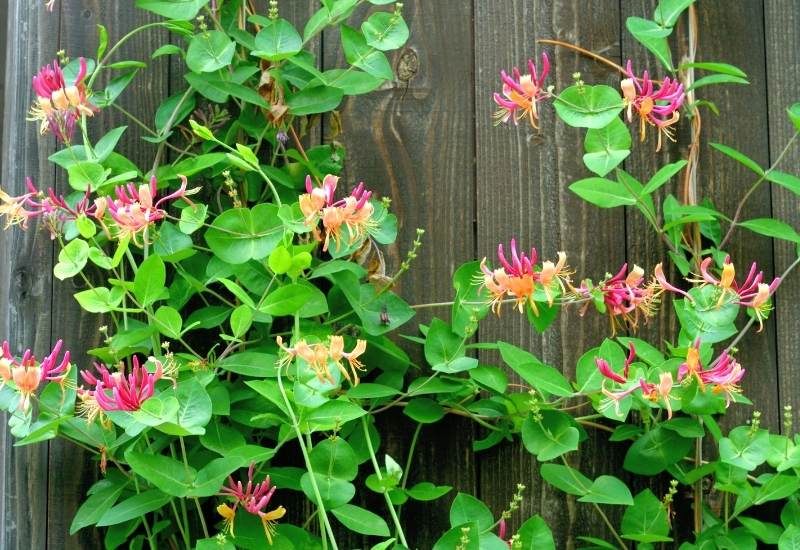
Honeysuckle is the classical looking vine for partial shade you want if have a natural looking garden and you want a fine and elegant effect.
It is a very vigorous twining climber with dense and florid foliage. The flowers are plenty and scattered all over the green backdrop.
They are sweet scented, and tubular, and they last for months. Depending on the actual species, the color range may change from pale yellow to orange red or purple.
Honeysuckle looks great on walls but also at the back of borders. So, if you have a wall at the back of a border that is not in full Sun and you want to mask it, honeysuckle is a great choice..
16. Atlantic Pigeon Wing (Clitoria mariana)
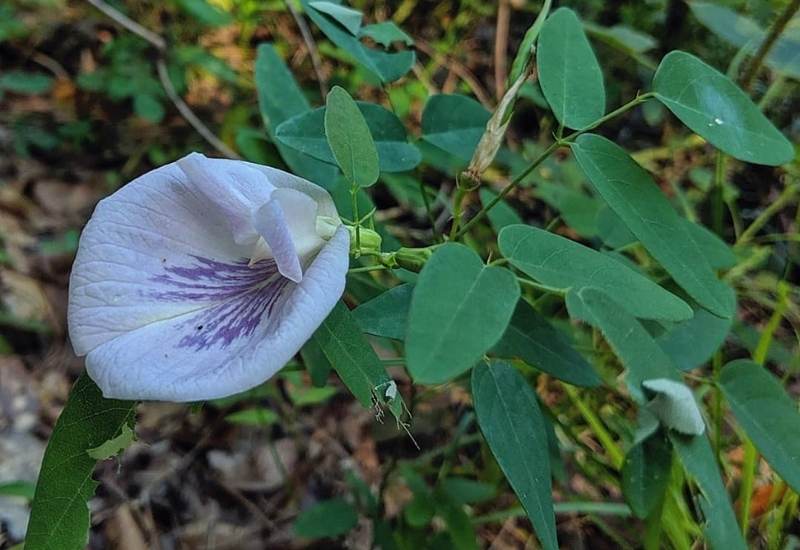
Atlantic pigeon wing is an ideal climber for a small space in partial shade. The flowers come in summer and they are quite original…
They are violet pink in color, and they have a long and large heart shaped petal that looks a bit like a tongue or a small shovel. These come on thin vines with beautiful three-pinnate leaves.
Atlantic pigeon wings will not grow too tall. For this reason, it is ideal for a short trellis, or a small wall.
17. Wild Potato Vine (Ipomoea pandurata)
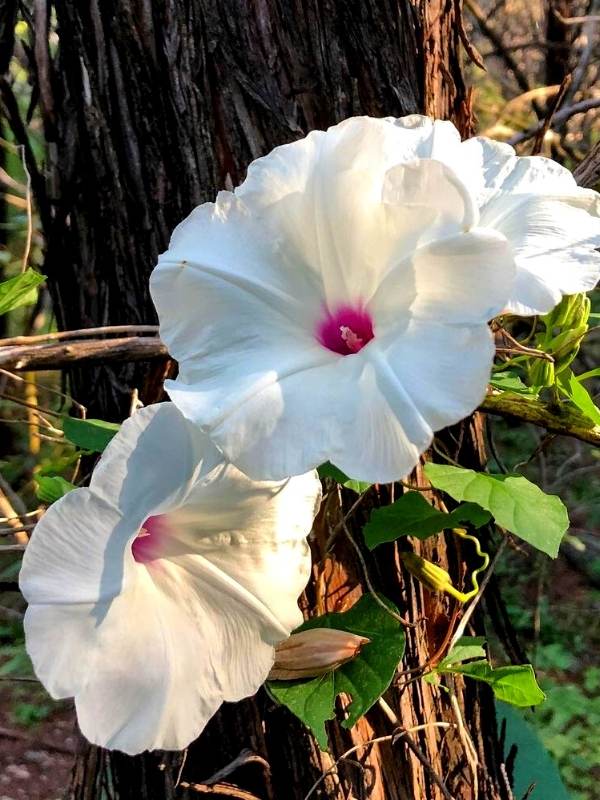
Lacking full Sun does not mean not having showy flowers and wild potato vine proves it! This close relative or morning glory has large funnel shaped blooms with a deep magenta center and white outer parts of the joint petals.
They open in the morning and close again in the evening, leaving the heart shaped leaves with red petioles to carry on the show.
It is perfect to cover unsightly spots like ugly fences, and if you wonder why it is called “wild potato vine”, it’s because you can eat the tubers of this climber because they are edible.
18. Butterfly Vine (Mascagnia Macroptera)
Butterfly vine can turn any area in part shade into a real original spectacle. This climber has very weird flowers in fact. They are canary yellow and the petals are thin at the base then form round spherical shapes.
But this perennial takes its name from the seed pods that follow… They a copper red and they look like the wings of butterflies! And the foliage has a thick and smooth tropical look as well.
If the place in partial shade you have in mind is in an important, visible position this is the plant you want. In fact, it is ideal for a front fence or gate.
19. Star Jasmine (Trachelospermum jasminoides)
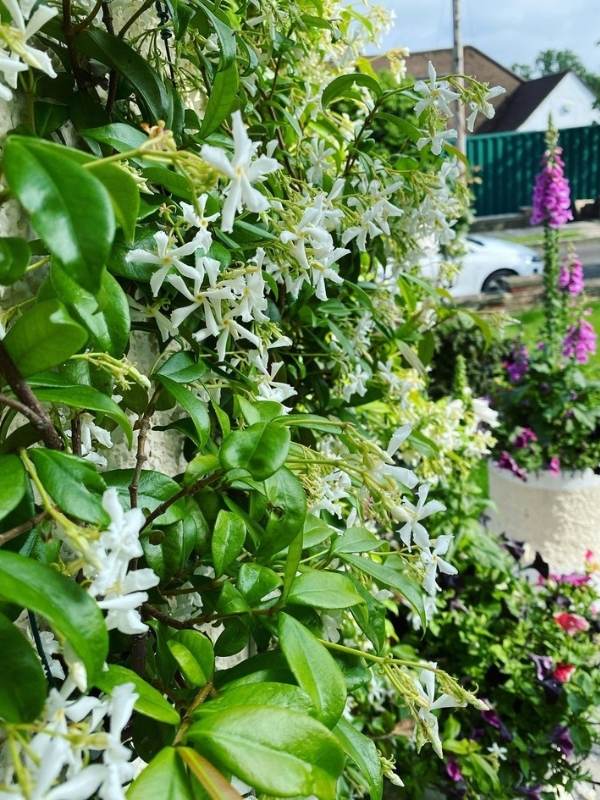
You can brighten up patios and gazebos in part shade with star jasmine, and also fill that space with the most intoxicating jasmine fragrance.
While it is not technically a Jasminum, in many parts of the world, this is the plant you call “jasmine”. The Mediterranean is full of these amazing evergreen climbers with cream white star, or “fan” shaped flowers.
They can cover whole walls, tall columns… I have seen some climb to the top of a block of flats!
This winner of the Award of Garden Merit by the Royal Horticultural Society is a real “star” of vines!
You can literally create a wall that’s green all year round and it becomes white once or twice a year. And you can smell it from far away!
20. Sweet Peas (Lathyrus spp.)
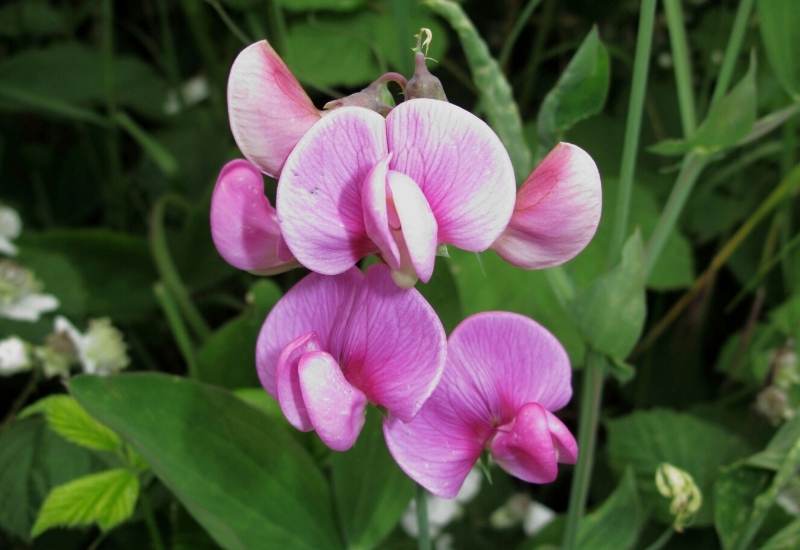
Sweet peas are a whole world of climbing colors and sweetness, and they don’t mind partial shade.
Fragrant and colorful like few other flower genera in the world, these easy to grow beauties bloom for months on end.
They grow fast and they are the only annual vines that made it to the shortlist. But they deserve to close it, because they can turn a sad wall or gate into a wonder of Nature in a matter of weeks!
If you start growing sweet peas you may end up becoming a fanatic… there are so many different varieties, literally of all colors!
And if you have little time to bring color and vitality to that shady spot in your garden, and even little money, sweet peas are just perfect and they never disappoint!
Now Set that Shady Spot Alight with Amazing Flowering Climbers!
I bet you never thought that an article about climbers for shade could contain so many vibrant colors and amazing flowers!
True, they are mainly for part shade, because few plants actually bloom in full shade, where the main climbers are ivy and similar creepers. But most gardens do not have actual full shade…
I hope this journey has given you a few ideas to brighten up that sad corner at the back of your garden…

Written By
Adriano Bulla
After many years as an academic in London, Adriano Bulla became a writer, publishing books like A History of Gardening, Organic Gardening and Elements of Garden Design; he then decided to become a gardener, following his childhood dream, and has been following his dream writing and gardening professionally in Southern Europe, where he has specialized in new and innovative organic gardening fields and techniques, like permaculture, regenerative agriculture, food forests and hydroponics.

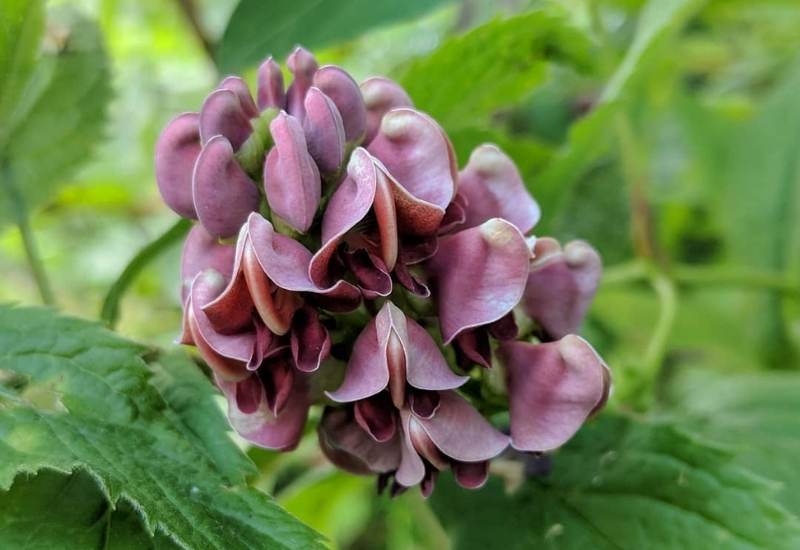
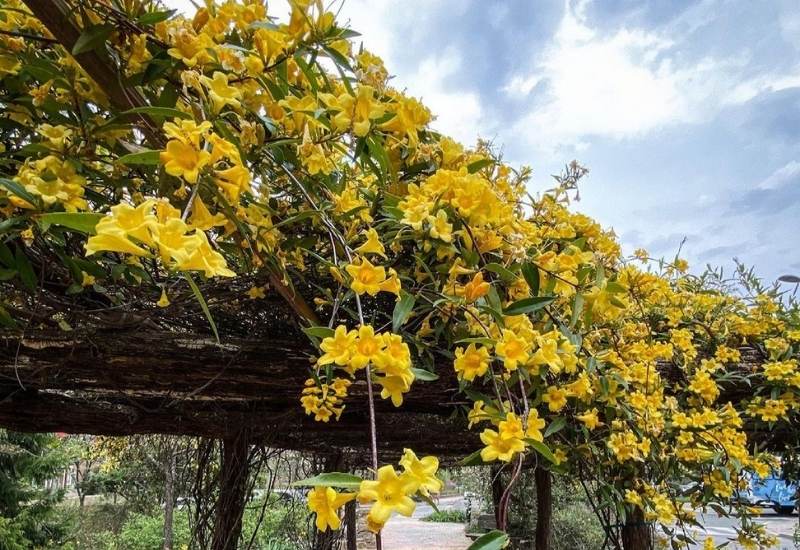
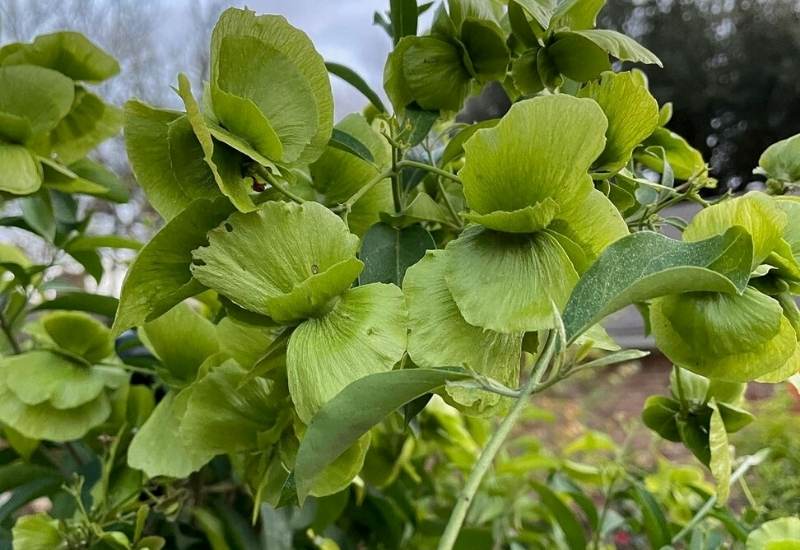
Is there a climbing vine for true ‘full shade’? I have a fence that is under fully-leafed trees in summer that I would like to soften with a trailing vine. I attempted honeysuckle but it is too dark for it to exist beyond one season. One dark summer and it expires ! Color me stumped at this point (and cutting back the trees is not an option unfortunately).
If you can get them to grow, how about moonflowers? Depending on your growing zone, might be an annual, but they open at night (and in your full shade would probably open during the day too). I don’t have much luck getting them to grow, but hear that they’ll readily self seed for the following year.
I used to plant morning glories, four oclocks and moon flowers around my porch. They vined all over the place and were a great source of privacy (I tied string all across the railing to the ceiling).beautiful flowers all day and night. I planted them by seed, originally. It was very hot and humid and I didn’t water them they grew from spring to fall.